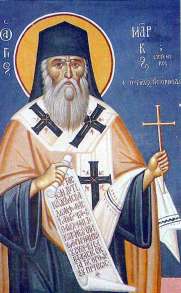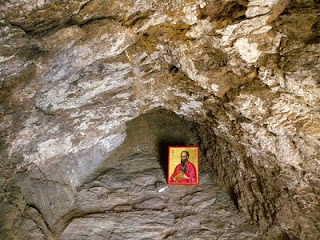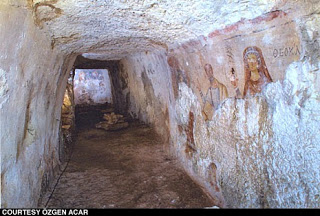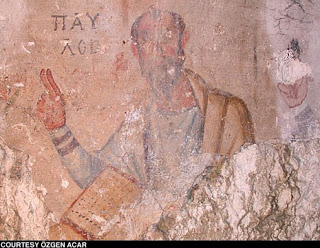The Weblog Of John Sanidopoulos
The Cave of Saint Paul in Ephesus
Пещера апостола Павла в Ефесе
Kryphi Panagia (“Hidden Virgin”) also called “The Cave of St. Paul”
In the course of excavations at Ephesus, more than 3,500 inscriptions have been found to date. Some of the most interesting are in a small cave on the slope of Bülbül Dagh mountain (Nightingale Mountain). The cave has three names, the oldest of which “Kryphi Panagia” means “Hidden Virgin,” and comes from the local legend that when St. John brought the Blessed Virgin Mary to Ephesus from Jerusalem, they had no place to stay. John found this cave and hid Mary there for her safety. It was not until some time later that John located a more suitable home for Mary higher up on the mountain, known as Panagia Capouli. In more recent years, the cave has been re-named “the Cave of St. Paul” or “the Grotto of St. Paul,” due to the Early Christian frescoes and inscriptions on the walls which refer to Paul. The name was given by one of the foremost researchers, archaeologist Dr. Renate Pillinger of Vienna.
The cave has been a Christian sacred site since the 1st or 2nd century. Its walls have been decorated with frescoes and inscriptions over the course of many centuries, white-washed several times, then re-painted with new images. Discovered under plaster on the walls are important 6th-century frescoes, accompanied by inscriptions, depicting the Virgin Mary, St. Paul and St. Thecla (a female disciple of Paul). This is the only known depiction of Paul at Ephesus and the earliest known appearance in the world of Paul and Thecla together.
The cave was discovered by a group of Lazarist priests, Fathers Henri Jung and Eugene Poulin in 1892, while looking for the tomb of the Blessed Virgin Mary. It was “re-discovered” in 1906 and excavated by the Austrian Archaeological Institute. Karl Herold, head of the restoration department, uncovered some of the frescoes beneath the plaster on the cave walls.
The cave consists of a corridor leading to a back room cut into the rock which served as a chapel for religious services. In the corridor there are two niches in the walls blackened with soot from lamps which lighted these alcoves centuries ago. Under the layers of plaster on the corridor walls are Greek phrases such as “the hidden of Mother of God” and “Paul help your servant” - written in charcoal and chalk. To protect these delicate and ancient wall frescoes, the cave is not open to the public.
According to the Austrian Archaeological Institute, during the course of the systematic excavation of the cave, over 500 graffiti and inscriptions, dating from the 5th to the early 20th century, have been discovered on the partially uncovered frescoes. Most of these texts have to do with religious invocations.
http://www.johnsanidopoulos.com/2014/07/the-cave-of-saint-paul-in-ephesus.html






